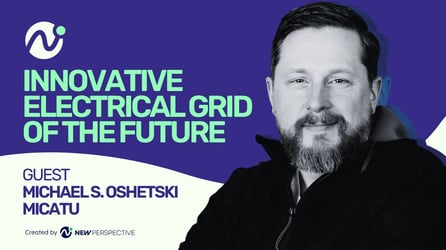Episode Info
Jean-François Gauthier from GHGSat explains how their satellites monitor greenhouse gas emissions at the facility level, shares a success story of detecting a methane leak in the UK, and discusses the challenges and policies around implementing this technology. He also introduces GHGSat's Spectra platform for visualizing emissions data.
🎥 Guest: Jean-François Gauthier, Senior VP of Strategy
📝 Full episode transcript
Hi, and welcome to the Green New Perspective Spotlight. So, can you tell me a bit more about yourself and the company, GHGSat?
Yes, the company is GHGSat. Thank you for having me. It’s great to be here. GHGSat is a company founded in 2011 with the ambition to monitor greenhouse gas emissions directly from industrial sources using satellites.
Up until then, satellites had looked at greenhouse gases on a global or regional scale to inform climate science, but it had never been done at the facility level. That was the ambition. The motivator for this was the establishment of a carbon trading system between the state of California in the U.S. and the province of Quebec, where GHGSat is located in Canada. The realization came that if we’re going to trade carbon credits like this, there’s going to be a need to measure carbon very accurately.
Our founder and CEO, Stefan, looked at the state of affairs for measuring greenhouse gases and realized that the methods to measure were few and far between, very costly, and, worst of all, quite inaccurate. So, there was a need for a different solution. His background was in the space business, so it was a natural fit to look at doing this for the first time and try to solve this challenge.
It took five years to launch the first satellite. The first satellite launched in 2016 after the design and construction phase. This satellite proved that it could indeed be done. We had amazing results from it, learned a lot of lessons, and made improvements to the design. Now, we have 12 of these satellites in orbit, 11 of them measuring methane emissions from sectors like oil and gas, coal mining, and landfills. Last November, we also launched our first CO2 satellite.
We work with industry and governments, using this data to inform them about emissions directly from sites so they can address them, and so regulators can better understand what’s going on in their territories.
Can you share a success story?
We’ve had many interesting success stories over the years, but one of my favorite ones lately happened in the UK. We were working with researchers from the University of Leeds, looking at landfills near a town called Cheltenham. We were doing this through a European Space Agency program called Third Party Mission (TPM), providing data to the University of Leeds through that program.
In that imagery, there were no emissions at the landfill, but a detection was noticed nearby. It seemed to be in the middle of nowhere, near a railroad, which was puzzling. We worked with the University of Leeds to overlay maps of pipelines in the area and realized that a pipeline followed the railroad closely. By sending people on the ground, we confirmed a pipeline leak. We contacted the utility responsible for the pipeline, and very quickly, it was fixed. Later on, our imagery confirmed the leak was no longer visible.
This is a small example of how the technology can be used to identify a methane leak, which can be damaging to the environment and dangerous to residents. Methane, as the main component of natural gas, could cause an explosion if ignited. This is a shining example of how useful the technology is for identifying these opportunities for mitigation so action can be taken swiftly.
Can you talk a bit about the challenges with implementing the technology? You also mentioned policies—what needs to change to make this tech more widely adopted?
The policies are changing. Regulations have evolved considerably in the last five years, especially in the last two or three years. The U.S., Canada, and the European Union have created very clear regulations on how methane should be addressed. The European Union went further by requiring that emissions from the entire value chain be measured and accounted for. For example, if gas is imported into European countries, the emissions at the extraction point—whether in the U.S., Algeria, Qatar, or anywhere else—must be measured as part of the value chain. This is novel and drives the need for technologies like ours to be adopted and deployed more widely.
Satellites are just one tool. Many technologies, including aircraft, drones, and in-situ sensors, have evolved significantly over the last 10 years. All these technologies work together to provide a full view of emissions. The advantage of satellites is that they can come back frequently, allowing frequent measurements without deploying personnel on the ground. This makes it easy to measure regularly, and frequent monitoring is important because many emissions are intermittent. They come and go, so if you only measure once in a while, you don’t get the full picture, and you don’t know where to prioritize action.
Regulations and new technologies are working together. It’s no longer a question of how to solve the problem but how to put the data to work. Sometimes companies are proactive because they’ve set their own goals. Other times, regulations or shareholders drive action, demanding performance and progress towards goals like achieving net zero by 2050. It’s no longer enough to say, “We care about emissions” in an annual report. You need to show progress, and measurement technologies like ours are crucial for showing that progress.
Since this is a short conversation and an introduction to what you’re doing, can you tell our audience where they can explore more and reach out?
We have a lot of information on our website, but we also have a platform called Spectra, where our data can be visualized. This is the platform our customers use to access and visualize the data, and they can select the timeline for viewing emissions. Spectra also allows the general public to sign up for free access and see examples around the world. We update it weekly with new examples from landfills, coal mines, and oil and gas sites, showing where emissions take place. This helps raise awareness and understanding of global emissions and their sources. It’s a great starting point for anyone interested.
Thank you, Jean François, for being my Spotlight guest.
It's a pleasure. Thank you so much for having me.
📚 Episode resources and links
-
🔗 Web: https://www.ghgsat.com
-
🔗 LinkedIn: https://www.linkedin.com/company/ghgsat-inc/
🎧 Subscribe to our podcast
💬 Follow GNP on Social




